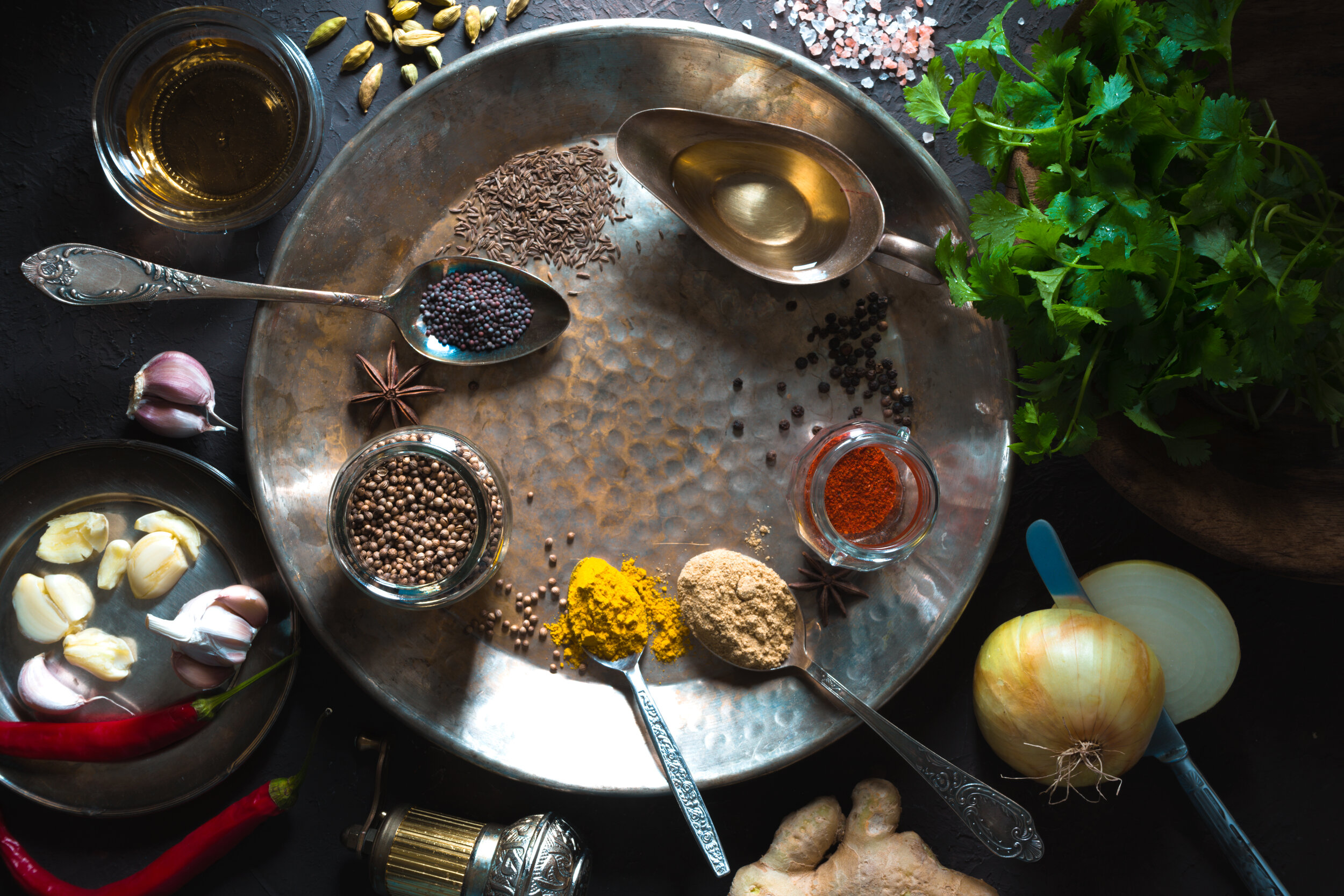Stock your Vegetarian Indian Pantry + Recipes
I was in a bookstore in Seattle in 1991, when I picked up a vegetarian Indian paperback and flipped through the pages. The recipes felt complicated with unfamiliar ingredients and steps. I bought the book, but it sat on my shelf before I got it together to attempt an Indian meal. I cooked out of that book for a long time, always returning to my tried-and-true recipes. I’ve come a long way. Now, I’m comfortable cooking a wide variety of regional Indian cuisines.
What I longed for then was me now, to help me figure out Indian food — what to buy, and how to cook it. I want to be that someone for you. I’ve mapped out what to stock in your Vegetarian Indian pantry, and everything listed I buy at our Food Coop. That’s why you won’t see every type of legume on my list.
I cook Indian food several times a week, using an Instant Pot, and it’s become a go-to standard. Indian cuisine isn’t difficult once you get the hang of it. Begin with a simple meal of dahl, chutney and chapatis. That will keep you happy for a while. Unless you want to get a little crazy, add to your pantry over time. Try to add something every shopping trip — and I’m serious about buying those whole spices and grinding them yourself!
I’ve made a list of equipment that I use, but you can cook amazing food with only a pot, spoon and wood fire. It’s all in the attitude and joy you bring to it.
My all-time favorite Indian cookbook
Lord Krishna’s Cuisine The art of Indian Vegetarian Cooking
Indian cooking videos are helpful and fascinating
Two of my favorite Indian Cooking Films
The Complete Indian Pantry Guide
Lentils
Red lentil
Black beluga
Pardina
Beans
Red Kidney
Chickpea
Adzuki
Mung
Small red chili
Peas
Yellow Split Pea
Black-eyed peas
Grains
Basmati white rice
Black forbidden rice
Millet
Raw buckwheat groats
Amaranth seeds
Cornmeal
Sorghum flour
Wheat flour
Nuts
Cashews
Coconut flakes
Peanuts
Pistachios
Almonds
Seeds
Hulled sesame seeds
Flax seeds
Psyllium seed husk powder
Sunflower seeds
Pumpkin seeds
Poppy seeds
Nigella seeds (not used often)
Dried Fruits
Raisins
Dates
Prunes
Figs
Fats
Coconut oil
Red palm oil (sustainable brand)
Ghee
Avocado oil
Sesame (not toasted)
Bags, jars and cans
Canned Diced tomatoes
Full fat canned coconut milk
Apple cider vinegar
Coconut sugar (closest in taste to jaggery)
Sea salt
Jars of pickled jalapenos (for making chutney)
Tamarind paste (essential)
Dairy
Whole milk (to make paneer cheese and yogurt)
Unsalted butter (to make ghee)
Bulk Whole Spices
Asafetida (not used often)
Allspice
Anise
Black peppercorns
Black mustard seeds
Bay leaves
Cayenne powder
Green cardamom pods
Ginger root dried
Cinnamon sticks
Cumin seeds
Coriander seeds
Cloves
Fennel
Fenugreek
Paprika
Nutmeg whole
Thyme dried
Turmeric powder
Red pepper flakes
Dried chilies (all types)
Fresh Produce
Herbs
Cilantro
Mint
Dill
Parsley
Greens
Cabbage (green and red)
Kales (and other sturdy greens)
Spinach
Beet greens
Roots Tubers and Alliums
Carrots
Onions
Garlic
Ginger
Turmeric
Beets
Sweet potatoes
Potatoes
Other vegetables
Peas
Green beans
Cauliflower
Peppers
Squashes
Corn
Fruits
Limes
Lemons
Apple
All fruit in season
Equipment
Instant Pot (nice but not essential)
Spice grinder (essential)
Food processor (handy)
Vitamix or flour mill (If you make bread!)
Griddle (essential)
Tortilla press (handy)
Instant Pot Creamy Lentils
Makes 1 ½ quarts
1 hour
Creamy and full of luscious flavors, this lentil dish will surprise, delight and have you coming back for more. If this were everyone’s introduction to lentils, we’d eat a lot more of them. If you haven’t tried different lentils, this is your opportunity. In a pinch, regular brown lentils will work.
Ingredients
Instant Pot
¼ cup ghee
2 onions chopped
8 cloves garlic, chopped
4 slices fresh ginger with peel (about 2 tablespoons minced)
4 slices fresh turmeric with peel (about 2 tablespoons minced)
1 ½ cups Pardina or beluga lentils, washed and sorted
1 teaspoon fine sea salt
3 cups water
To finish
1 can (14 ounces) full fat coconut milk
¼ cup tomato paste
1 tablespoon apple cider vinegar
1 tablespoon garam masala
Fine sea salt to taste
Garam Masala
2 tablespoons coriander seeds
1 tablespoon cumin seeds
½ teaspoon allspice berries
1 teaspoon green cardamom pods with hulls removed
2 dried bay leaves
1 teaspoon red pepper powder
2 teaspoons cinnamon
Directions
Instant Pot
Using a small food processor, grind the garlic, ginger and turmeric together into a rough paste.
On high saute, melt the ghee and saute the onions for 8 minutes. Add the wet paste and continue to saute for 2 minutes more. Add the lentils, salt and water. Check the IP seal and put the lid on. Set to high pressure for 30 minutes with a natural release.
Using a spice grinder, grind the spices for garam masala. When the lentils are done, add coconut milk, tomato paste, garam masala, apple cider vinegar and salt to taste. Stir and correct if needed. Use the extra garam masala within two weeks.
Creamy Cashew Lime Coconut Chutney
Makes 1 pint
Quick
Irresistible, creamy and wholesome, this chutney from Kerala, is versatile as a dip for veggies, thinned down as a salad dressing, or accompanying South Indian savories.
Ingredients
2 cups raw cashews
3 tablespoons fresh lime juice
1½ teaspoons Maldon sea salt flakes
1-inch piece of unpeeled ginger root, minced into a paste
1 teaspoon pickled diced jalapeno
⅓ cup unsweetened coconut flakes
2 tablespoons amber coconut nectar (or replace with coconut sugar)
1 cup water
Instructions
In a high-powered mixer (Vitamix), blend all the ingredients together until smooth. A little chunky piece of cashew here and there is fine. Eat immediately or refrigerate for up to 2 weeks.
Fresh Coriander Chutney
Makes 2 cups
Quick
A smooth, flavorful chutney, as popular in Punjab as pesto is in Genoa.
Ingredients
dry roast ingredients
1 teaspoon cumin seeds
3 tablespoons hulled sesame seeds
¼ cup unsweetened coconut flakes
¼ cup chopped Brazil nuts
1 large bunch cilantro, washed and roughly chopped including stems
6 green onions chopped, including green parts
1 1/2 teaspoons pickled jalapeno
1 inch of fresh ginger, unpeeled, finely minced
1 teaspoon fine sea salt
1 tablespoon coconut nectar (or an equal amount coconut sugar)
¼ cup fresh lemon juice
½ cup water or more as needed to make a smooth (pesto consistency) chutney
Instructions
Dry roast the first four ingredients, in a heavy frying pan, on a low heat, stirring frequently, until the coconut and nuts darken a few shades.
In a high-powered blender (Vitamix), Combine the dry-roasted ingredients with the remaining ingredients and process until smooth, adding more water, a little at a time, if needed.
Transfer to a bowl and serve, or store and keep refrigerated for up to a week.
Isabgol Sunflower Seed Chapati
Makes 12 chapati
30 minutes
These chapati are delicious, flexible, store well, are grain-free, prebiotic, high fiber and once you get the hang of them, easy to make.
Ingredients
1¼ cup sunflower seeds
4 tablespoons psyllium seed powder (Isabgol)
2 teaspoons baking powder
1 teaspoon sea salt
4 tablespoons flax meal
2 tablespoons apple cider vinegar
1 cup boiling water
Olive oil for hands and press
Special Equipment
Electric griddle or crepe pan. High-powered blender (Vitamix), tortilla press or rolling pin, parchment paper, liquid measuring cup
Instructions
Set out a tortilla press with a piece of parchment paper folded in half to fit inside the press. Or, fold a piece of parchment paper in half and have a rolling pin ready.
Preheat a griddle on medium high.
Have a liquid measuring cup and a rubber spatula set out.
Have 2 cups of water ready at a boil. (I turn my electric kettle on.)
Measure the vinegar out into a small dish and set aside.
Add dry ingredients to a high-powered blender, blend into a flour, stopping before it becomes sunflower butter! A few sunflower seed pieces are ok.
Dump the flour into a mixing bowl, and quickly measure the boiling water, add vinegar to the water and pour into the flour. Stir well with a rubber spatula, until the flour is mixed into the liquid. It will make a choux paste like dough.
Using a tortilla press
Oil your hands and divide the dough evenly into 12 balls. Open the piece of parchment paper and rub oil onto it. Lay a ball between the oiled parchment paper, between the two sides of the tortilla press, and press. Open the parchment paper, flip the chapati so it’s laying on your open hand and peel off the parchment paper from its other side. Lay the chapati on the hot griddle. Immediately press the next chapati in the same way. Usually, a griddle will hold three chapatis at a time. Cook for 3 minutes on one side, flip and cook for another 2 minutes. Stack them on a plate and let them firm before eating.
Using a rolling pin
Oil your hands and divide the dough evenly into 12 balls. Open the piece of parchment paper and rub oil onto it. Lay a ball between the oiled parchment paper, and roll in all directions until it’s about 6 inches in diameter. Open the parchment paper, flip the chapati so it’s laying on your open hand and peel off the parchment paper from its other side. Lay the chapati on the hot griddle. Immediately press the next chapati in the same way. Usually, a griddle will hold three chapatis at a time. Cook for 3 minutes on one side, flip and cook for another 2 minutes. Stack them on a plate and let them firm before eating.
Notes: They keep well and are even better reheated on a griddle. When they’re reheated, the sunflower seeds taste toasted. It’s possible to pre-grind dry ingredients and refrigerate or freeze them, and then it’s just a matter of adding the liquid, pressing and cooking the chapatis. Psyllium seed is a high fiber food, so it’s important to drink liquid with the chapati.




